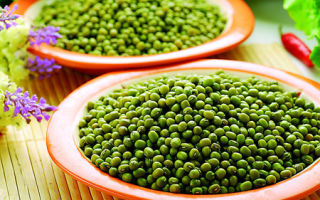Content
- 1 What is mung
- 2 The composition and calorie content of mung bean cereals
- 3 Health benefits of mung bean cereals
- 4 The benefits of sprouted mung bean
- 5 How to germinate mung bean at home
- 6 Mash in cosmetology
- 7 How to cook delicious mung bean
- 8 How mung bean differs from peas and beans
- 9 The harm of mung bean and contraindications to use
- 10 How to choose and store mung bean
- 11 Conclusion
- 12 Reviews
Mung bean is an exotic plant, the fruits of which are eaten as a grain crop. It is more common in Asia, in Europe, including in Russia, little is known about it. We will talk about this culture, about its properties, about the benefits and harms of mung bean, and how to use it at home, in this article.
What is mung
This annual agricultural plant belongs to the legume family, which is easy to guess from the appearance of its fruits and grains - the seeds of mung bean are round-oval, bright green or green, similar to young peas or beans. The birthplace of culture is India, where it is called "mung beans", this name is now used in other countries.
Much is popular not only in India, China, Korea, Japan and the countries of Southeast Asia, but also in Turkmenistan, Uzbekistan, Tajikistan, Turkey, where they are well aware of its beneficial properties. It is eaten in the form of green pods, ripe or sprouted grains, preparing dishes from them with the addition of various ingredients.

The composition and calorie content of mung bean cereals
As with all legumes, mung bean is high in protein. In 100 g of seeds, its 23.5 g. This amount is enough to cover the daily human need for this nutrient by 30%. There are also a lot of carbohydrates, there are 46 g of them in the grain, and only 2 grams of fat. Fiber in 100 g of mung bean 11 g, water 14 g, the rest is occupied by minerals (K, Ca, Mg, Na, Ph, Fe) and vitamin compounds, especially C, E, PP and group B, of which there are a lot of this useful grain. Due to its high carbohydrate and protein content, mung bean is a nutritious food. The calorie content of mung bean is 300 kcal per 100 g of product.
Health benefits of mung bean cereals
With regular use of mung bean for food, minerals and vitamins are supplied to the body, which are necessary for the normal course of many vital processes. For example, potassium takes an active part in maintaining the balance of water, acids and electrolytes, in conducting nerve impulses and normalizing pressure; bone and dental tissue is formed from calcium, it also participates in muscle contraction.
In addition, mung bean has other beneficial effects on the body. The benefits of mung bean are that they:
- strengthen the immune system;
- improve memory and stimulate mental activity;
- due to the diuretic effect, they cleanse the body of toxic compounds and prevent the formation of edema;
- exhibit antioxidant properties, preserving the youth of tissues and organs;
- restore vision and prevent its decline;
- have a stabilizing effect on hormones and the nervous system;
- slow down the growth of tumor cells.
Mung beans, useful in all respects, are a good prophylactic agent, preventing diseases of the kidneys, heart and blood vessels, as well as respiratory and autoimmune diseases. Mung bean is also useful for diabetes, as it lowers blood sugar.
The benefits of sprouted mung bean
Besides the cooked whole dry mung bean, these beans are also eaten sprouted.The benefits of mung bean sprouts are mainly expressed in the fact that the body receives a lot of easily digestible protein and vitamins, which are formed during the germination of grain. Along with the sprouted beans, simple, not complex carbohydrates get inside, which means that the body does not spend extra energy on processing them.
The sprouts of mung bean contain more than 2 dozen useful mineral elements, which in many ways, and some almost completely, satisfy a person's daily need for them. According to doctors, sprouted mung bean is useful to everyone, including pregnant and lactating mothers, so it can and even should be consumed during these crucial periods of a woman's life.
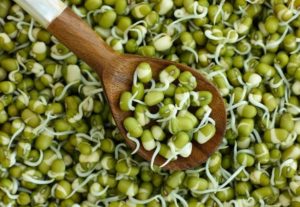
How to germinate mung bean at home
It is very easy to sprout mung beans at home, even easier than cereal grains. To do this, you will only need a small container made of ceramic, glass, plastic or an enamel bowl, a piece of clean gauze or a thin towel, mung beans themselves and clean cold water.
The process of cooking sprouted beans is also not difficult for any housewife:
- It is necessary to take a vessel, pour mung into it.
- Soak it in warm water for about 8 hours.
- Then drain the water, rinse the beans in cold clean water.
- Cover the bowl with wet cheesecloth and place in a warm, bright place.
- After about 12 hours, healthy sprouts should already appear on the beans.
It is believed that the most benefit from mung bean sprouts is if they do not exceed 2 cm in length, so it makes no sense to germinate the beans longer. Store the finished product in a household refrigerator for no more than 5 days and be sure to rinse it in water before eating. Healthy mung bean with sprouts can be eaten alone, combined with other sprouted grains, or added to salads instead of the green peas they taste like, vegetable soups, and stews and fried vegetable dishes.
Mash in cosmetology
The benefits of mung beans are expressed not only in the fact that they nourish the body from the inside, they can also be beneficial for the skin of the face and body. They make home remedies to cleanse and nourish the skin.
Facial scrub
To prepare it, you must first grind dry mung bean grains in a coffee grinder, and if it is not there, then buy flour from these beans. Preparation technology:
- 2 tsp ground beans mix with 2 tsp. mint or pink decoction (for thin or sensitive skin);
- 2 tsp masha mix with 2 tsp. lemon juice or honey (for oily skin);
- leave to brew for 10-15 minutes.
Apply the mung bean scrub on your face in a circular motion, keep it on your face for 10 minutes, and then simply rinse off with warm water. Apply a couple of drops of olive oil to the skin and massage into it.
Facial mask
To prepare this homemade cosmetic, you need 1 tbsp. l. mixed with 1 tbsp of powdered mung bean. l. sour cream and 1 tsp. olive oil. You can add 1 more drop of your favorite essential oils. Mix everything well and apply the mixture to a wet face. Leave it on for 15–20 minutes, then rinse with water.

How to cook delicious mung bean
You can cook a variety of dishes from it, for example, cook porridge, stew with vegetables, cook soup with beans. These simple dishes are easy to prepare, no special skill is needed, and the process itself does not take much time.
Porridge recipe
They love to cook this dish in the East, and it is not surprising, because it is very tasty and nutritious. You will need:
- rice and mung bean - 200 g each;
- medium-sized onions and carrots - 1 pc .;
- fresh meat (beef, goat or lamb) - 400 g;
- vegetable oil - 50-100 ml;
- spices (black, red pepper, cumin) and salt;
- water - 1.5 l.
How to cook mung bean porridge:
- Peel the vegetables, rinse and dice the carrots and the onions into thin half rings.
- Cut the meat into small pieces.
- Fry it in oil along with vegetables and spices and put in a saucepan.
- Pour the beans into it, add water and cook over low heat for 40 minutes.
- After that, add rice and cook until the water is completely boiled away.
Serve hot mung bean porridge, along with fresh dill and parsley.
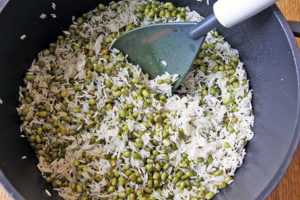
Soup recipe
To make this vegetable soup, you will need:
- 100-150 g mung bean;
- 1 onion and 1 medium carrot;
- 2-3 medium potatoes;
- 200 g of chicken;
- 100 g butter;
- 2 tbsp. l. homemade sour cream;
- spices and salt to taste.
Step by step description of cooking:
- Put meat in a saucepan, cover with water and cook until half cooked.
- Then fry the onions and carrots in oil.
- Add mung beans and potatoes to the meat.
- 10 minutes before the end of cooking, put onions with carrots, spices and salt, and last of all sour cream.
- Serve the mung bean soup hot.
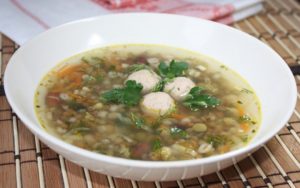
How mung bean differs from peas and beans
The main advantage of mung beans is that it cooks quickly. It is not necessary to soak it, but you can put it in a saucepan as usual. And one more property of these beans - they do not cause gas formation, so they can be eaten even by people with problems of this kind and babies from 6 months.
The harm of mung bean and contraindications to use
Mung bean can bring not only benefits, but also harm to the body. But this is only for misuse. It should not be eaten by people who have gastrointestinal disorders, decreased intestinal motility, and also intolerance to any components of the product.
How to choose and store mung bean
The best mung beans are fresh, smooth, and bright green. They should not have any damage or stains, they should not be dry or wrinkled. You need to store them in a dry, dark place where they can lie for 2 years without changing the quality. Store ready-made mung bean dishes in the refrigerator for no more than 5 days.
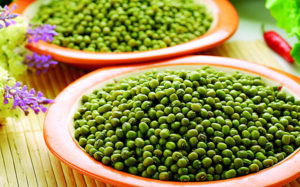
Conclusion
What will be the benefits and harms of mung bean also depends on whether it was chosen, stored and prepared correctly. If you do everything right, it will become not only useful, but also a favorite dish for the whole family.
Reviews

